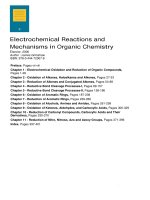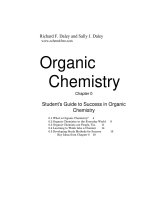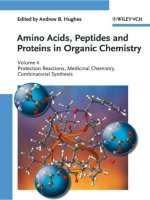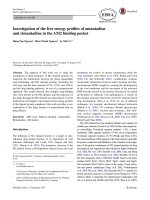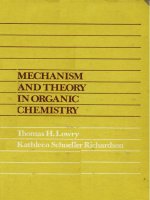Free energy relationships in organic and bio organic chemistry
Bạn đang xem bản rút gọn của tài liệu. Xem và tải ngay bản đầy đủ của tài liệu tại đây (2.09 MB, 313 trang )
www.pdfgrip.com
Free Energy Relationships in Organic and Bio-organic Chemistry
www.pdfgrip.com
This book is dedicated to William P. Jencks
and the late Myron L. Bender
www.pdfgrip.com
Free Energy Relationships in
Organic and Bio-organic Chemistry
Andrew Williams
University of Kent, Canterbury, UK
www.pdfgrip.com
ISBN 0–85404–676–3
A catalogue record for this book is available from the British Library
© The Royal Society of Chemistry 2003
All rights reserved
Apart from any fair dealing for the purpose of research or private study, or criticism or
review as permitted under the terms of the UK Copyright, Designs and Patents Act, 1988,
this publication may not be reproduced, stored or transmitted, in any form or by any means,
without the prior permission in writing of The Royal Society of Chemistry, or in the case of
reprographic reproduction only in accordance with the terms of the licences issued by the
Copyright Licensing Agency in the UK, or in accordance with the terms of the licences
issued by the appropriate Reproduction Rights Organization outside the UK. Enquiries
concerning reproduction outside the terms stated here should be sent to The Royal Society
of Chemistry at the address printed on this page.
Published by The Royal Society of Chemistry,
Thomas Graham House, Science Park, Milton Road,
Cambridge CB4 0WF, UK
Registered Charity Number 207890
For further information see our web site at www.rsc.org
Typeset by RefineCatch Limited, Bungay, Suffolk
Printed by TJ International Ltd, Padstow, Cornwall
www.pdfgrip.com
Preface
Proper interpretation of free energy relationships can provide detailed
information involving charge distribution in the transition structure of
a reaction mechanism. Free energy relationships are thus of enormous
significance in studies of mechanism and this text is offered as a coursebook for senior undergraduates and postdoctoral workers engaged in
such investigations. Since publication in 1973 of previous monographs at
this level there have been substantial developments in the theory and
application of free energy relationships and their application to reaction
mechanism. This is especially true of the concepts of effective charge and
similarity and the text demonstrates how these concepts can be used to
elucidate physico-chemical attributes of transition structures. These
concepts are therefore likely to be of significance as vehicles for the
treatment of free energy relationships in undergraduate courses at the
senior level and in postgraduate courses.
Results from free energy relationships are generally easy to achieve
but, since they are probably the most difficult to interpret, the technique
has been the subject of fierce critical appraisal. The most extreme
criticism has used the existence of apparent anomalies to deny any usefulness of the relationships. These criticisms have led to an undeservedly
poor appreciation of free energy relationships; this, together with
fashion, has ensured that free energy relationships scarcely figure in
contemporary chemistry courses at any level and has denied students
access to a major technique for studying mechanism. On the contrary
the apparent anomalies of free energy relationships provide extremely
important insights into mechanism, in particular regarding the relative
timing of the fundamental processes of a reaction under investigation.
Free energy relationships continue to provide one of the major routes via
which knowledge of reaction mechanism can be derived.
The text is a source for the most commonly used free energy relationships; it is meant to be self contained and while most of the terms
employed in it are standard or are defined in the text reference can
be usefully made to the IUPAC glossary of terms used in physical
organic chemistry.a Sufficient data are provided in the form of empirical
a
P. Müller, Pure Appl. Chem., 1994, 66, 1077; />
www.pdfgrip.com
vi
Preface
equations and tables of parameters for the reader to calculate physicochemical constants. The book can be used without attempting the
problems, in which case the answers in the appendix provide further
illustrative material.
For clarity, the examples discussed in the text and used as problems do
not as a rule include contributions from other techniques. One of the
most serious problems associated with studies of reaction mechanism
is over-confidence in the power of a single technique or theory. By its
very nature a monograph focusses on a particular subject, and in this
case the text should not be construed as an argument that the technique
of free energy relationships is the only tool worthy of use in mechanistic
studies.
I am delighted to acknowledge the help of the following colleagues
who have read parts of the text in its early form or who have made useful
suggestions: Stefano Biagini (Kent), Bill Bentley (Swansea), Howard
Maskill (Newcastle), Herbert Mayr (Munich), Mike Page (Hudderseld), Franỗois Terrier (Versailles) and Sergio Thea (Genoa). I am also
grateful to Katrina Turner and the staff of the Royal Society of Chemistry at Cambridge for their help in the preparation of the book and to
the School of Physical Sciences at the University of Kent for providing
me with facilities.
Andrew Williams
Canterbury, July 2003
www.pdfgrip.com
Contents
Chapter 1
Free Energy Relationships
1
1.1
3
1.2
1.3
1.4
1.5
1.6
1.7
1.8
Chapter 2
Mechanism and Structure
1.1.1 Interconversion of States – Reaction
and Encounter Complexes
Universal Measure of Polarity
Classes of Free Energy Relationship
Origin of Free Energy Relationships
Similarity and the Leffler α-Parameter
Bonding in Transition Structures
Further Reading
References
4
5
6
7
10
12
13
15
The Equations
17
2.1
2.2
17
19
23
24
26
27
30
32
32
34
35
The Hammett Equation (Class II)
The Taft Equation (Class I)
2.2.1 Steric Demand at Reaction Centres
2.3 Inductive Polar Constants σI
2.3.1 Choice of σ Value
2.4 The Brønsted Equation (Class I)
2.5 The Extended Brønsted Equation (Class II)
2.6 Equations for Nucleophilic Substitution
2.6.1 The Swain–Scott Equation (Class II)
2.6.2 The Ritchie Equation (Class II)
2.7 Solvent Equations
2.7.1 The Grunwald–Winstein Equation
(Class II)
2.7.2 The Kosower Z and Reichardt ET Scales
(Class II)
2.7.3 The Hansch Equation (Class II)
2.8 Other Standard Processes
2.8.1 Spectroscopic Transitions
2.8.2 Acidity and Basicity Functions
2.8.3 Molar Refractivity
2.9 Further Reading
2.10 Problems
2.11 References
36
39
40
41
41
42
43
44
45
51
www.pdfgrip.com
viii
Chapter 3
Contents
Effective Charge
55
3.1
55
58
63
3.2
3.3
3.4
3.5
Chapter 4
Equilibria
3.1.1 Measuring Effective Charge in Equilibria
3.1.2 A Group Transfer of Biological Interest
3.1.3 Additivity of Effective Charge in
Reactants and Products
Rates
3.2.1 Additivity of Effective Charge in Transition Structures
3.2.2 Effective Charge Maps for More Than
Two Bond Changes
Further Reading
Problems
References
65
65
67
67
69
69
73
Multiple Pathways to the Reaction Centre
75
4.1
4.2
4.3
75
78
79
80
83
86
88
88
89
4.4
4.5
4.6
4.7
Strength of the Interaction
Additivity of Inductive Substituent Effects
Multiple Interactions
4.3.1 The Jaffé Relationship
4.3.2 Resonance Effects
4.3.3 The Yukawa–Tsuno Equation
4.3.4 Other Two-parameter Equations
4.3.4.1 The Dewar–Grisdale Equation
4.3.4.2 The Swain–Lupton Equation
4.3.4.3 The Edwards Equation for
Nucleophilic Aliphatic
Substitution
4.3.4.4 The Mayr Equation
Multi-parameter Solvent Equations
4.4.1 Extension of the Grunwald–Winstein
Equation
4.4.2 The Swain Equation
4.4.3 Extended Hansch Equations
4.4.4 Solvent Equations Based on Macroscopic Quantities
Further Reading
Problems
References
92
93
94
94
94
96
96
97
97
103
www.pdfgrip.com
ix
Contents
Chapter 5
Coupling Between Bonds in Transition Structures
of Displacement Reactions
5.1
5.2
5.3
5.4
5.5
5.6
5.7
Chapter 6
Cross and Self Interaction Between Two or
More Substituent Effects
5.1.1 Hammond and Cordes–Thornton
Coefficients
Shapes of Energy Surfaces from Coupling
Coefficients
5.2.1 General Acid-catalysed Addition of
Thiol Anions to Acetaldehyde
5.2.2 Reaction of Amines with Phosphate
Monoesters
5.2.3 Elimination Reactions of
2-Arylethylquinuclidinium Ions
Magnitude and Sign of Cordes–Thornton
Coefficients
Identity Reactions
Further Reading
Problems
References
Anomalies, Special Cases and Non-linearity
6.1
6.2
6.3
6.4
6.5
6.6
6.7
6.8
6.9
6.10
6.11
Free Energy Relationships are not Always
Linear
6.1.1 Marcus Curvature
The Reactivity–Selectivity Postulate
Bordwell’s Anomaly
Microscopic Medium Effects and Deviant
Points
Statistical Treatment of Brønsted Plots
Are Free Energy Relationships Statistical
Artifacts?
The Ortho Effect
Temperature Effects
Further Reading
Problems
References
107
107
109
110
115
116
117
118
119
123
124
126
129
129
131
135
138
140
144
145
146
147
148
149
154
www.pdfgrip.com
x
Chapter 7
Appendix 1
Contents
Applications
158
7.1
158
158
Diagnosis of Mechanism
7.1.1 Mechanism by Comparison
7.1.2 Effective Charge Distribution of the
Transition Structure
7.1.2.1 Effective Charge Maps and
Conservation of Effective Charge
7.1.2.2 Charge and Bond Order Balance
7.2 Demonstration of Intermediates
7.2.1 Curvature in pH-profiles
7.3 Demonstration of Parallel Reactions
7.3.1 Concave Curvature in pH-profiles
7.4 Demonstration of Concerted Mechanisms
7.4.1 Technique of Quasi-symmetrical
Reactions
7.4.2 Criteria for Observing the Break
7.4.2.1 Effective Charge Map for a
Putative Stepwise Process
7.5 Calculation of Physico-Chemical Constants
7.5.1 Dissociation and Equilibrium Constants
7.5.2 Rate Constants
7.5.3 Partition Coefficients and Other
Constitutive Molecular Properties
7.6 Resolution of Kinetically Equivalent
Mechanisms
7.6.1 General Base versus Nucleophilic
Reaction
7.6.2 General Acid Catalysis Versus
Specific Acid–General Base
Catalysis
7.7 Some Biological Applications
7.8 Further Reading
7.9 Problems
7.10 References
182
184
187
189
196
Equations and the More O’Ferrall–Jencks Diagram
201
A1.1 Summary of Equations
A1.1.1 The Morse Equation
A1.1.2 Derivation of Equation 7 (Chapter 1)
201
201
202
160
160
161
163
166
166
168
169
169
173
173
174
174
179
180
181
181
www.pdfgrip.com
xi
Contents
A1.1.3 The Effect of ∆Eo on the Leffler α
Parameter
A1.1.4 Fitting Data to Theoretical Equations
A1.1.4.1 Linear Equation
A1.1.4.2 Bilinear Equation
A1.1.4.3 Global Analysis of Two
Linear Equations
A1.1.4.4 Binomial Equation
A1.1.4.5 Cross-correlation
A1.1.5 Effective Charge from Hammett Slopes
A1.2 The More O’Ferrall–Jencks Diagram
202
202
203
203
204
205
206
206
207
Appendix 2
Answers to Problems
210
Appendix 3
Tables of Structure Parameters
258
Appendix 4
Some Linear Free Energy Equations
282
Subject Index
290
www.pdfgrip.com
www.pdfgrip.com
CHAPTER 1
Free Energy Relationships
There are many techniques of varying degrees of generality for the study
of mechanisms and that of free energy relationships is the most readily
applicable and general. Free energy relationships comprise the simplest
and easiest of techniques to use but the results are probably the trickiest
to interpret of all the mechanistic tools.
The quantitative study of free energy relationships was first introduced
by Brønsted1 and Hammett2 in the early part of the twentieth century. As
well as playing a major rôle in understanding and deducing mechanism,
free energy relationships have been incorporated into software to provide
computational methods for calculating physico-chemical parameters
of molecules. Such techniques are of substantial technical importance in
drug design3 where parameters such as solubility, pKa, etc. can be useful
indicators of the biological activity of chemical structures of potentially
therapeutic compounds. Free energy relationships may be employed in
the design of synthetic routes.4
The most recent undergraduate texts devoted to free energy relationships were published in 1973.5,6 Since that time the application of free
energy relationships to the study of organic and bio-organic mechanisms
has undergone substantial transformation and fierce critical appraisal.
The slopes of linear free energy correlations of polar substituent effects
are related directly to changes in electronic charge (defined as effective
charge)7 at a reaction centre. Since charge difference is a function of
bonding change, polar substituent effects are related to bonding
in the transition structurea relative to that in the reactant;8 it has to be
a
The term transition state refers to a hypothetical quasi-thermodynamic state. Transition structure
(formerly called the activated complex) refers to the molecular structure at the potential energy
maximum on the reaction path which, unlike reactants and products, has no stability (see for
example H. Maskill, Mechanisms of Organic Reactions, Oxford Science Publications, Oxford,
1996).
www.pdfgrip.com
2
Chapter 1
recognised that this relationship is often not a simple one. Effective
charge is measured by comparing the polar substituent effect with that
of a standard equilibrium, such as the (heterolytic) dissociation of an
acid, where the charge difference is arbitrarily defined. Comparison of
the polar substituent effect with that of a standard dissociation is a
special case of the similarity concept where the change in free energy in a
reaction or process is compared with that of a similar standard process.
This way of utilising the polar substituent effect provides a direct
relationship between an empirical parameter (the slope of the free energy
relationship) and an easily understood physical quantity, namely charge,
developing in the reference process.
Polar substituent effects are observed when there is a change in the
polarity of the substituent in the system. The observer’s tool (the
substituent change) is part of the system being observed and will thus
affect the results. The observational effect is inherent in all measurements
(which must be made by an observer) but is usually negligible, for
example in chemical experiments involving relatively non-invasive techniques, such as electromagnetic radiation, as the means of observation.
In free energy relationships the effect could be serious unless it is
recognised. Indeed, as we shall see in Chapters 5 and 6 the curvature
sometimes observed in free energy correlations is a direct consequence of
the connection between observational tool and observed reaction centre.
The additional complication that changing the substituent could have
a gross effect on the mechanism is a very useful tool as explained in
Chapter 7.
We shall be discussing the following main attributes of the technique
of free energy relationships throughout the text:
• Linear free energy relationships are empirical observations
•
•
•
•
which can be derived when the shapes of the potential energy
surfaces of a reaction are not substantially altered by varying the
substituent.
The slopes of linear free energy relationships for rate constants are
related to transition structure.
Transition structure is obtained from knowledge of the bond orders
of the major bonding changes as well as of solvation.
Changes in the shape of the energy surface of a reaction give rise to
predictable changes in the slopes of free energy relationships.
Polar substituent effects arise from changes in electronic charge
in a reaction brought about by bond order and solvation
changes.
www.pdfgrip.com
Free Energy Relationships
3
1.1 MECHANISM AND STRUCTURE
The mechanism of a reaction is described as the structure and energy
of a system of molecules in progress from reactants to products. This
representation gives rise to an expectation that experimental methods
should indicate the structures as shown in static diagrams; it obscures the
fact that the experimental techniques refer to assemblies of structures
each of which has rotational, vibrational and translational activity.
An assembly of reactant molecules is converted into product
molecules through an assembly of transient structures which are not
discrete molecules. Even though the structures making up the transition
state assembly are not interconvertible within the period of their lifetimes (10−13 to 10−14 seconds) the assembly is postulated to have a normal
thermodynamic distribution of energies.9 A definition of mechanism
which can be fulfilled experimentally, at least in principle, is a description
of any intermediates and the average transition structures intervening
between these intermediates, reactants and products. This definition of
mechanism is currently employed in mechanistic studies. More fundamental knowledge, such as that of the structure of the system between
reactant and transition structure, is at present largely in the realm of
theoretical chemistry.b
Structure requires a description of the relative positions of nuclei and
the electron density distribution in a system. The existence of zero-point
vibrations indicates that even at absolute zero the exact positions of
atoms in a molecule are uncertain. As the temperature is increased,
higher quantum states are occupied for each degree of freedom so that
fluctuations around the mean positions of atoms increase. In order to
discuss the mechanism of any reaction, it is necessary to bear in mind
precisely what the term structure means. A pure compound is usually
visualised as an assembly of molecules each comprising atoms which
have identical topology relative to their neighbours. The exact relative
position of each atom is time-dependent, and a bond length, measured
on a collection of molecules, is an average quantity. The two-dimensional
static structures possessing bonds represented by lines (Lewis bonds)
are hypothetical models. These structures, commonly designated Kekulé
structures, are very convenient for visualising organic molecules as
they are easily comprehensible and are easily represented graphically in
two dimensions. Although they are often taken for reality (particularly
in their three-dimensional form) they are simply representations of
hypotheses which fit experimental knowledge of the compounds.
b
See however A.H. Zewail, Science, 1988, 242, 1645 and A.H. Zewail (ed.), The Chemical Bond,
Structure and Dynamics, Academic Press, New York, 1992.
www.pdfgrip.com
4
Chapter 1
The reaction coordinate10 is a measure of the average structure taken
by a single molecular system on passage from reactants to products.
Structure usually equates with potential energy. The transition structure
is not a molecular species and corresponds to the maximum of the Gibbs
free energy in the system on progression from reactant to product state.
The free energy is distributed amongst the available quantum states
of the various degrees of freedom of the collection of pseudo-molecules
of the transition state.
The structure of the molecular species in the transition state is thus an
average but it should be stressed that this is no different in principle from
that of a discrete molecule which is also an average.c
1.1.1 Interconversion of States – Reaction and Encounter Complexes
In a bimolecular reaction in solution reactants diffuse through the
assembly of solute and solvent molecules (Scheme 1) and collide to form
an encounter complex within a solvent cage. Reaction is not possible until
any necessary changes occur in the ionic atmosphere to form an active
complex and in solvation (such as desolvation of lone pairs) to form a
reaction complex in which bonding changes take place. The encounter
complex remains essentially intact for the time period of several
collisions because of the protecting effect of the solvent surrounding
the molecules once they have collided. The products of the subsequent
reaction could either return to reactants or diffuse into the bulk solvent.
Scheme 1
Bimolecular mechanism in solution (ns = 10 −9 sec; fs = 10 −15 sec)
A similar description applies to a unimolecular reaction except that
formation of the transition structure is initiated by energy accumulation
in the solvated reactant by collision.
Scheme 2 gives typical half-lives for reactant molecules destined to
react.11 Many encounters do not lead to reaction and only a small fraction
of the complexes will have the appropriate transition state solvation in
place to form a reaction complex and for reaction to proceed.
c
Even the most precise X-ray crystallographic measurements of structure associate the positions of
atoms in a molecule with error volumes.
www.pdfgrip.com
Free Energy Relationships
5
Scheme 2 Range of lifetimes of processes in a bimolecular mechanism in solution
(ps = 10 −12 sec)
Extracting conclusions from experimental results derived from reactions of collections of molecules requires the interpretation of measured
global energy changes in these collections as a function of “average”
structures. Free energy relationships provide an important technique
for carrying out this interpretation. In general polar substituents will
have their greatest effect on the process between reaction complexes
(A in Scheme 2). Solvent change is largely effective on processes B and C
but there is some effect on A due to solvent stabilisation of charge and
dipole caused by bonding change.
1.2 UNIVERSAL MEASURE OF POLARITY
It is commonplace that some groups withdraw electrons from a reaction
centre whereas others donate electrons. For example, a halo group
is expected to attract electrons relative to hydrogen, and alkyl groups
to donate electrons. Free energy relationships provide a means of
quantifying polar effects. The concept of relative polarity is not simply
that of an inductive effect (I) through σ-orbitals, because transmission
of charge can occur through space as a field effect (F) or through a
conjugated system of π-orbitals as a resonance effect (R). The extent
to which these three transmission vectors contribute to the overall
polarity of a substituent group is dependent on the system to which it is
attached.
The original measure of substituent polarity was chosen to be the
dissociation constant of a substituted benzoic acid in water (Equation
1).12,13 It is readily confirmed that the pKa of the benzoic acid is raised by
an electron donating substituent and lowered by an electron withdrawing
substituent.
www.pdfgrip.com
6
Chapter 1
A polar substituent changes the energy of the transition state of a
reaction by modifying the change in charge brought about by the bond
changes (Hine).14,15 Thus substituents that withdraw electrons and disperse negative charge will tend to stabilise a structure if there is an
increase in negative charge at the reaction centre (and vice versa). The
polar substituent must be suitably placed in the molecule for the effect
to be transmitted efficiently to the reaction centre through the bond
framework, space or solvent.
Most experimental techniques measure differences; a change in the
rate constant of a reaction brought about by a change of substituent
represents the difference in the effect on reactants compared with that on
the transition state. An increase in rate constant could result from the
reactant becoming less stable, a more stable transition state or a combination of these effects. The observed effect is due to the difference between
the effects on the reactant (∂Gr) and transition (∂G ‡) states as illustrated
in Scheme 3.
Scheme 3
The source of the substituent effect (∂∆G‡) on a rate process
1.3 CLASSES OF FREE ENERGY RELATIONSHIP
A free energy relationship is defined by Equation (2) where the parameter
a is called the similarity coefficient.
∆G = a∆Gs + b
(2)
The term ∆G is the free energy of a process such as a rate or equilibrium
and ∆Gs is the free energy of a standard process, often an equilibrium,
which could be the process under investigation or some other standard
reaction.
Equation (2) holds for many processes over relatively large changes
in free energy and is usually written in terms more directly related to
www.pdfgrip.com
7
Free Energy Relationships
those which have been experimentally determined such as the logarithms
(to base 10) of rate (k) or equilibrium (K) constants (Equations 3–5).d
logK = a1logKs + b1
(3)
logk = a2logKs + b2
(4)
logk = a3logks + b3
(5)
Class I free energy relationships compare a rate constant with the
equilibrium constant of the same process. The Brønsted and Leffler
equations (see Chapter 2) are examples of this class of free energy
correlation.
The rate or equilibrium constant in Class II is related to the rate or
equilibrium constant of an unconnected but (often) similar process.
Class II free energy relationships are in general more common than those
of Class I because equilibrium constants are more difficult to measure
than rate constants (except in certain cases such as dissociation constants). The Hammett equation is the best-known Class II free energy
relationship.
1.4 ORIGIN OF FREE ENERGY RELATIONSHIPS
The existence of Class I free energy relationships can be deduced from
the energy profile of a reaction.e Figure 1 illustrates what happens to the
profile as a substituent is changed. We shall assume that the reaction
(Equation 6) consists of a single bond fission (A᎐B → B + A)
A᎐B + C → A᎐C + B
(6)
and a single bond formation (C + A → A᎐C) related to inter-atom distance by Morse curves (see Appendix 1, Section A1.1). The intersecting
point (Figure 1) represents the transition structure where cross-over from
one system to the other results in a smooth junction between the two
processes (as shown). For small changes in overall energy the variation in
∆Ea is linearly related to the change in ∆Eo by Equation (7) (see Appendix
1, Section A1.2, for derivation).
d
e
This is because free energy is related to equilibrium and rate constants by logarithmic equations
∆G = −2.303RT logK and ∆G ‡ = −2.303RT logk + 2.303 RT logκkBT/h where κ is the transmition
coefficient and kB and h are Boltzmann’s and Planck’s constants.
The Class I relationship has been derived by the application of molecular orbital theory and for
details the reader is referred to M.J.S. Dewar, The Molecular Orbital Theory of Organic Chemistry,
McGraw-Hill, New York, 1969; R.F. Hudson, Angew. Chem. In. Ed., 1973, 85, 63; M.J.S. Dewar
and R.C. Dougherty, The PMO Theory of Organic Chemistry, Plenum Press, New York,
1975; A. Warshel, Computer Modelling of Chemical Reactions in Enzymes and Solutions,
Wiley-Interscience, New York, 1991, Section 3.7.
www.pdfgrip.com
8
Figure 1
Chapter 1
Two-dimensional potential energy diagram for Equation (6) formed from
combined Morse curves for the elementary processes A + C → A᎐C and A᎐B →
A+B
∂∆Ea =
m1
∂∆Eo
m1 + m2
(7)
Over the small range of ∆Eo the entropic component of the free energy
can be assumed not to change so that ∂∆G and ∂∆G ‡ are proportional
to ∂∆E and ∂∆E‡ respectively and Equation (8) follows.
∂∆G ‡ =
m1
∂∆Go
m1 + m2
(8)
Integration and rearrangement of this equation gives rise to the Class I
free energy relationship (Equation 9).16
logk =
m1
logK + b = alogK + b
m1 + m2
(9)
This equation fails if the slopes m1 and m2 change owing to large changes
in ∆Go. The Class I relationship can alternatively be derived from the
Marcus-type function (Chapter 6).
In the meantime it is necessary to define what is meant by the term
reaction coordinate. The reaction coordinate for a dissociation process
of a diatomic species is simply the distance between the atoms as
the reaction proceeds. The majority of reactions are not of diatomic
molecules and there is usually more than one bond undergoing a
major bonding change, so that the reaction coordinate can no longer
be regarded as a simple distance between atoms in a two-dimensional
www.pdfgrip.com
9
Free Energy Relationships
representation. For the purposes of Figure 1, the reaction coordinate
has the dimension of interatomic distance for each component process,
even though the identity of the major bonding change alters as the
system progresses from reactants to products.
The origins of the Class II free energy relationships are not so easy
to visualise as those of Class I in terms of a molecular model, because
there is no direct atomic interaction between the systems giving rise to
the two free energy changes (as in Figure 1). In this case it is necessary
to invoke chemical intuition to indicate that substituent effects on
chemically similar processes will be related to each other. No such
assumption is necessary in the Class I case.
Leffler and Grunwald devised a treatment which derives both Class I
and Class II free energy relationships and is more general than that using
crossed energy surfaces.17 The equation, ∂∆GR = a.∂GRs, relating the free
energy of reaction of the reactant XR with that of the standard reaction
XRs can be derived using the assumption that free energies of substances
are additive functions. Let us consider a transformation (Equation 10)
of a system (XR) comprising a single interaction between variable,
non-reacting, substituent (X) and the reacting group (R) and product
group (P).
XR
XP
(10)
The free energies of XR and XP are assumed to be additive functions:
G oXR = G oX + G oR + IX,R
G oXP = G oX + G oP + IX,P
and
where IX,R, IX,P are interaction terms between substituent X and the
molecule. Therefore
∆G oR = G oXP − G oXR = (G oP − G oR) + (IX,P − IX,R)
The standard or reference reaction (Equation 11)
XRS
XPS
(11)
has a free energy of reaction of:
∆G oRs = G oXPs – G oXRs = (G oPs − G oRs) + (IX,Ps − IX,Rs)
An assumption, the postulate of separability, is necessary so that the
interaction terms (IX,R) may be factored:
www.pdfgrip.com
10
Chapter 1
IX,R = IX IR
and the energies can therefore be written:
∆G oR = (G oP − G oR) + IX (IP − IR)
and
∆G oRs = (G oPs − G oRs) + IX (IPs − IRs)
Partial differentiation of these equations against the variable X leads to
∂∆G oR = ∂IX (IP − IR)
and
∂∆G oRs = ∂IX (IPs − IRs)
and Equation (12) results which is analogous to Equation (8).
∂∆G oR =
IP − IR
∂∆G oRs = a∂∆G oRs
Ps − IRs
ΆI
·
(12)
The assumption of a single interaction pathway and the separability
postulate are only likely to hold if the changes made in X are small.
Equation (12) could fail when there are large changes in X leading to
large changes in the standard or reference reaction (Chapter 6).
1.5 SIMILARITY AND THE LEFFLER ␣-PARAMETER
The similarity coefficient “a” in the free energy equation (Equation 2)
compares the change in the process under investigation (the unknown
system) with that for a standard or reference (the known) system. The
coefficient measures the similarity between the two systems. In the case
of Class I relationships the similarity coefficient measures the extent to
which the transition state resembles the products compared with the
reactants. The similarity coefficient for Class II systems measures the
extent to which conversion to the transition state resembles the conversion of reactants into products in the standard or reference system.
Free energy relationships are not confined to chemical reactivity or
www.pdfgrip.com
11
Free Energy Relationships
equilibria and can arise from comparisons of rate constants with solvent
parameters such as partition coefficients, concentrations or spectral
frequencies, all of which relate to energy changes. NMR chemical shifts
have been studied extensively as a function of substituent change18 as
have polarographic half-wave potentials and oxidation–reduction
potentials.19 Steric similarity coefficients also enable steric requirements
of reactions to be quantified in terms of the steric requirements of a
standard reaction.
The reference reaction in the case of Class I systems is the equilibrium
reaction of the system under investigation and therefore offers the best
possible comparison for determining a transition structure. For this
reason the Leffler equation (Class I) is commonly used to indicate the
structure of a transition state.20
Introduction of a substituent perturbs the energy of a reactant or
product. Change in the free energy of the transition state is assumed to
be a linear combination of the corresponding changes in reactants and
products (Equation 13)21 which can be expressed as Equation (14) with
0 < α < 1 and used to derive Equation (16) as below.
∂G ‡ = a∂G oXP + b∂G oXR
(13)
∂G ‡ = α∂G oXP + (1 − α)∂G oXR
(14)
∂G ‡ − ∂G oXR = α(∂G oXP − δG oXR)
(15)
Let
∆G ‡ = G ‡ − G oXR
and
∆G oR= G oXP − G oXR
∂∆G ‡ = ∂G ‡ − ∂G oXR
and
∂∆G oR = ∂G oXP − ∂G oXR
Therefore
Substituting for ∆G ‡ and ∆G oR into Equation (15) gives:
∂∆G ‡ = α∂∆G oR
(16)
The congruence between this equation and Equations (8) and (12) gives
some credence to the assumption of a linear combination (Equation 14),
and Equation (16) may be re-written as the Leffler Equation (17)
∂∆G ‡/δ∆G ST = α∂∆G oR /∂∆G ST
(17)
www.pdfgrip.com
12
Chapter 1
where ∆G ST refers to any standard equilibrium. The Leffler parameter α
may then be written in terms of Hammett (ρ), Brønsted (β) or general
similarity coefficients (a) as in Equation (18) where ρ or β refer to substituent effects on the rate constant and ρeq or βeq refer to substituent
effects on the equilibrium constant of the reaction.
α = ρ/ρeq = β/βeq = a/aeq
(18)
Since the transition structure lies between that of reactant (XR) and
product (XP) it is likely that changes in its free energy will be intermediate
between the corresponding changes for reactant and product (although
the standard free energy of the transition state is larger than those of
reactant and product). This can be expressed mathematically in Equation
(16) using a Leffler α-parameter which has a value between 0 and 1.
These relationships can be derived graphically as described in
Appendix 1, Section A1.3.
1.6 BONDING IN TRANSITION STRUCTURES
The strength of a bond undergoing a major change in a reaction may be
defined by its interatomic distance relative to that of reactant or product
in the reaction complex (RC, Scheme 2).22 The distance between the atoms
in a bond undergoing major change is only experimentally accessible
for reactants, products and intermediates but not for any of the other
structures, including the transition structures, on the path from reactant
to product. Although interatomic distance is employed extensively in
theoretical studies other measures of bonding must be sought for use in
experimental studies, and one of these is the polar substituent effect.f
The polar substituent effect relates to changes in charge or dipole in
the system that derive from the difference in electronic structure between
ground and transition state and for this reason is a measure of bonding.
Great care must be taken in interpreting polar substituent effects in terms
of the extent of bonding. The shorthand notation used in illustrating
reaction mechanisms tacitly implies that bonding change is the only
component to the energy in a reaction. Simply changing the solvent
can have enormous energy effects: for example, the gas-phase identity
displacement at methyl chloride by chloride ion has been shown to
possess no energy of activation whereas in solution the solvent interactions give rise to a substantial barrier.23
Considerable effort has been expended in discussion of polar
f
For other approaches to the study of bond strength in reaction mechanisms see R.L. Schowen and
R.D. Gandour (eds.), Transition States of Biochemical Processes, Plenum Press, New York, 1978.


